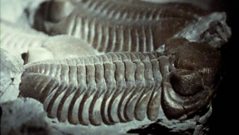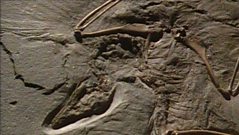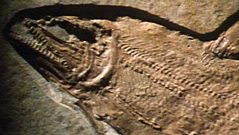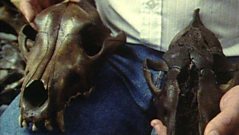
Petrified trees
Ancient trees still look like wood, but have turned to solid stone.
Some 220 million years ago these logs were part of trees that grew in a great confierous forest in this part of Arizona in the United States. When the trees died, some of them fell into the rivers and the logs were carried downstream and ultimately buried in these sands and gravels. And now, although they look exactly like wood, they are in fact solid stone. Because they are no longer flexible wood but brittle rock, these trunks have been broken into segments and look as if they have been sawn into short lengths. The bark has been perfectly preserved, so that you can see the grain and the knot holes from which small branches once sprang. The wood itself has been replaced by a mineral - quartz - but the annual growth rings can still be picked out so that you calculate just how old each huge tree was before it fell. In fact, these fossils retain so many of the characters of the original trees that botanists can work out exactly what kind they were. They were cypresses, related to the swamp cypresses that today still grow 1,500 miles away to the east in the flat, waterlogged plains along the coast of Florida and Louisiana. These forests give us a very accurate picture of what the petrified forests was like when it was alive. Conifers were not the first trees to clothe the Earth. 150 million years earlier there were trees of a very different kind. These, like giant horsetails, also grew in coastal swamps. Sometimes sea level rose and water swept into the swamps, bringing great quantities of sand and mud which buried and killed the trees. The outside of these trees had extremely toug bark, but the interior was soft and pithy, and ecayed very rapidly when the tree died. As it decayed, more sand settled in the place of the wood, but the bark remained for a much longer time, separating the sand inside the trunk from the sand outside. over millions of years the sand compacted and formed sandstone, and when quarried it broke away where the bark have been to reveal these extraordinary trunks. In effect these are casts of the trees. They give a vivid impression of the the forest that grew 350 million years ago where today the city of Glasgow stands.
Duration:
This clip is from
Featured in...
![]()
麻豆社 Nature
Be captivated, informed and inspired by the world's wildlife.
More clips from Magic in the Rocks
-
![]()
Amber treasure
Duration: 02:42
-
![]()
Mud fossils
Duration: 00:50
-
![]()
Fossil folklore
Duration: 01:00
-
![]()
How amber forms
Duration: 02:25
More clips from Lost Worlds, Vanished Lives
-
![]()
Trilobite types—Putting Flesh on Bone
Duration: 02:30
-
![]()
Missing link—The Rare Glimpses
Duration: 02:28
-
![]()
Limestone legacy—The Rare Glimpses
Duration: 03:17
-
![]()
Fossil analysis—The Rare Glimpses
Duration: 01:49










